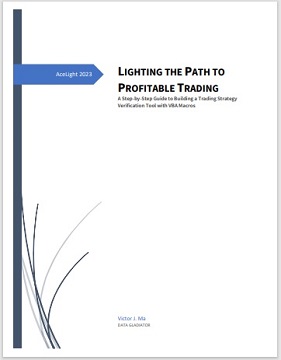6 Common Stock Trading Strategies for Beginners
|
|
Ah, the eternal struggle between the bulls and the bears. It's like watching
a slapstick comedy routine performed by oversized mascots. The bulls charge
forward, filled with optimism, shouting, "To the moon!" while the bears
slump, grumbling, "Prepare for the crash!" It's a perpetual dance where the
punchline is never quite clear, and you find yourself wondering if you
accidentally wandered into a circus instead of the stock exchange.
Stock trading is not just about numbers and charts; it's a psychological
battlefield. Fear, greed, panic, and hope form a dysfunctional comedy troupe
that takes turns hijacking your rational thinking. One moment, you're
laughing at your own audacity for buying a "hot stock" based on a friend's
uncle's neighbor's advice, and the next, you're nervously checking your
portfolio as if it were a lottery ticket about to reveal its fate.
Stock trading can be an exciting and potentially profitable endeavor, but
for beginners, it can also be overwhelming and risky. The key to success in
the stock market lies in understanding and implementing effective trading
strategies. In this blog post, we will delve into various stock trading
strategies specifically designed for beginners, providing you with valuable
insights and examples to help you navigate the market with confidence.
1. Long-Term Investing:
Long-term investing is a strategy that
focuses on buying and holding stocks for an extended period, typically
several years. This approach is based on the principle of capitalizing on
the long-term growth potential of companies. It is particularly suitable for
beginners who are looking for a more passive and less time-consuming
investment strategy.
Example: Let's consider a beginner investor who
purchases shares of a well-established technology company with a strong
track record of innovation and growth. By holding onto these shares over the
long term, the investor benefits from the company's overall growth
trajectory and potential dividend payments.
2. Value Investing:
Value investing involves identifying undervalued stocks that are trading
at a price lower than their intrinsic value. The idea behind this strategy
is that the market sometimes undervalues certain stocks, presenting
opportunities for investors to acquire them at a discounted price. Value
investing requires careful analysis of a company's financials and
fundamentals.
Example: A beginner investor may research and identify
a retail company that has experienced a temporary setback due to negative
market sentiment. However, a thorough analysis of the company's financials
reveals that it possesses strong assets, consistent cash flow, and a solid
business model. The investor decides to purchase the stock, expecting its
value to rise as the market recognizes its true worth.
3. Dollar-Cost
Averaging:
Dollar-cost averaging is a simple yet effective strategy
that involves investing a fixed amount of money into a particular stock or
exchange-traded fund (ETF) at regular intervals, regardless of the stock's
price. This strategy mitigates the risk associated with market fluctuations
by spreading the investment over time.
Example: A beginner investor
decides to invest $500 every month into a diversified ETF that tracks the
performance of the S&P 500 index. By consistently investing the same amount,
the investor is able to buy more shares when prices are low and fewer shares
when prices are high. Over time, this approach reduces the impact of
short-term market volatility.
4. Growth Investing:
Growth
investing centers around identifying and investing in companies with high
potential for rapid earnings growth. This strategy focuses on companies that
are expanding their market share, launching innovative products, or
disrupting industries. While growth stocks can be volatile, they can also
deliver substantial returns.
Example: A beginner investor recognizes the
growing demand for renewable energy solutions and researches companies
within this sector. After careful analysis, the investor identifies a solar
energy company with a strong pipeline of projects, technological
advancements, and a visionary leadership team. By investing in this growth
stock, the investor aims to benefit from the company's expected expansion
and rising stock price.
5. Momentum Trading:
Momentum trading
involves capitalizing on the upward or downward momentum of stock prices.
This strategy relies on identifying stocks that are experiencing significant
price movements and entering trades to ride the trend. Momentum traders
often use technical analysis indicators, such as moving averages and volume
analysis, to inform their trading decisions.
Example: A beginner
investor notices a pharmaceutical company whose stock price has been
steadily rising due to positive clinical trial results for a potential
breakthrough drug. By utilizing momentum trading, the investor enters a
position to take advantage of the upward price movement and sells when the
momentum starts to fade.
6. Dividend Investing:
Dividend
investing involves focusing on stocks that provide regular dividend payments
to shareholders. Dividend-paying stocks can provide a consistent income
stream for investors, making this strategy particularly appealing for
beginners seeking passive income.
Example: A beginner investor
researches well-established companies with a history of stable dividends.
They identify a utility company with a long-standing track record of paying
regular dividends. By investing in this stock, the investor not only
benefits from potential capital appreciation but also receives regular
dividend payments, contributing to their overall investment returns.
 No
matter how perfect a trading strategy works in theory, we need to test it
before we really use it in the market. These tests include back-testing and
forward-testing. The same one stock trading strategy works for different
stock and uses different parameters, there will be hundreds or even
thousands of different results. We need some methods and tools to verify
which trading strategy works well for which stock, and under what
conditions. Our tutorial handbook is offering some methods and tools to
execute these testing and verifying tasks. You can download it for free,
click here:
LIGHTING THE PATH TO PROFITABLE TRADING: A Step-by-Step Guide to Building a
Trading Strategy Verification Tool with VBA Macros No
matter how perfect a trading strategy works in theory, we need to test it
before we really use it in the market. These tests include back-testing and
forward-testing. The same one stock trading strategy works for different
stock and uses different parameters, there will be hundreds or even
thousands of different results. We need some methods and tools to verify
which trading strategy works well for which stock, and under what
conditions. Our tutorial handbook is offering some methods and tools to
execute these testing and verifying tasks. You can download it for free,
click here:
LIGHTING THE PATH TO PROFITABLE TRADING: A Step-by-Step Guide to Building a
Trading Strategy Verification Tool with VBA Macros
And click Free Trial to download strategies testing tools, all for a 30-day Free Trial.
Click on Subscription to order more strategies testing tools to help your stock trading.
As a beginner in the stock
market, understanding and implementing effective trading strategies is
crucial for success. Whether you choose a long-term investing approach,
value investing, dollar-cost averaging, growth investing, momentum trading,
or dividend investing, each strategy offers unique opportunities and
considerations. It is essential to conduct thorough research, stay informed
about market trends, and continually educate yourself to adapt to the
dynamic nature of the stock market. By employing these stock trading
strategies and refining your skills over time, you can enhance your chances
of achieving your financial goals and building a strong investment
portfolio.
It's a wild ride filled with comedic twists, outrageous
characters, and unexpected surprises. And who knows, maybe one day you'll
look back at your early trading days, have a good chuckle, and realize that
amidst the laughter, you've also managed to build a successful portfolio. |


|

Free Tutorial
Share
|
|
|
|